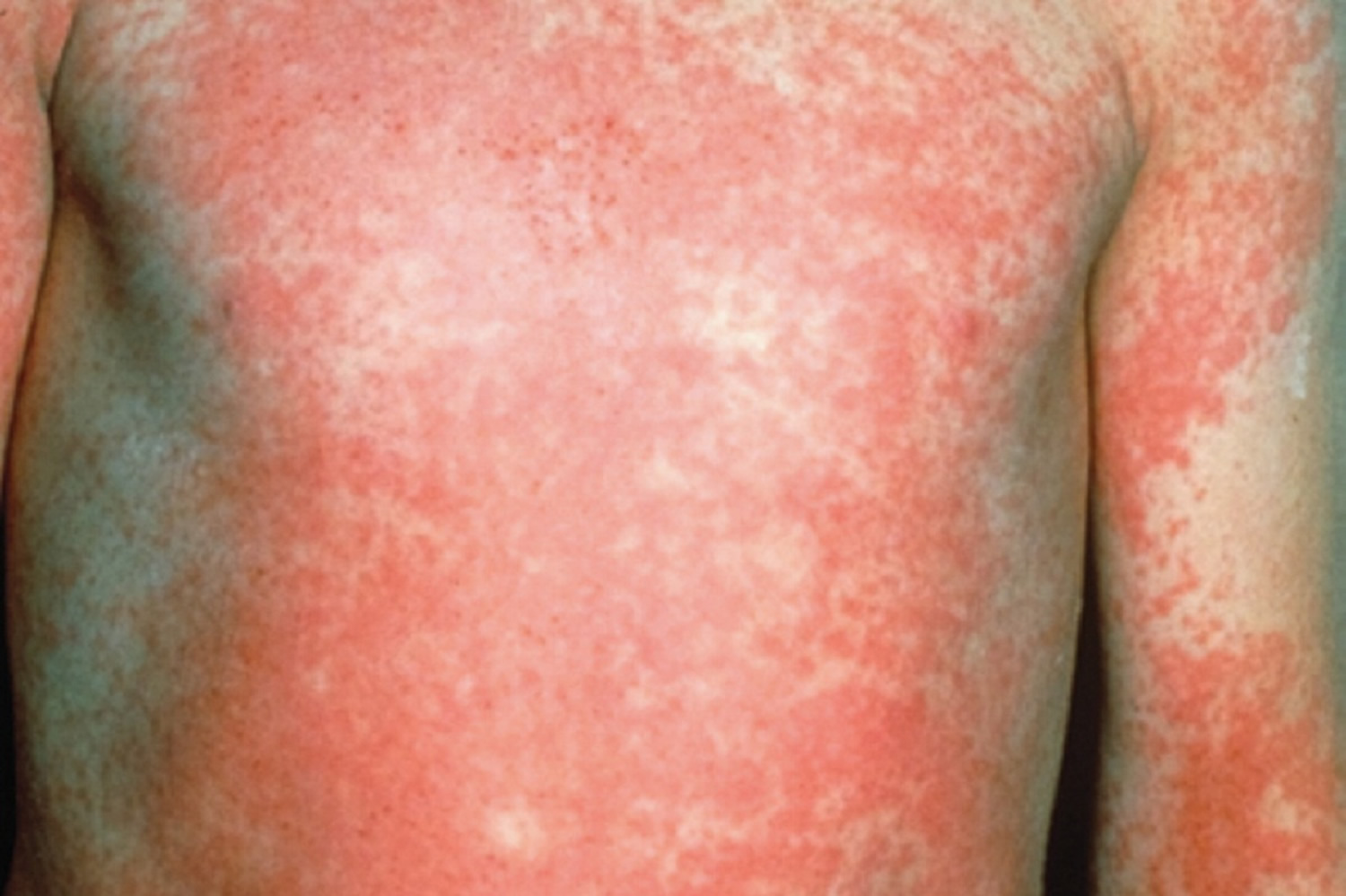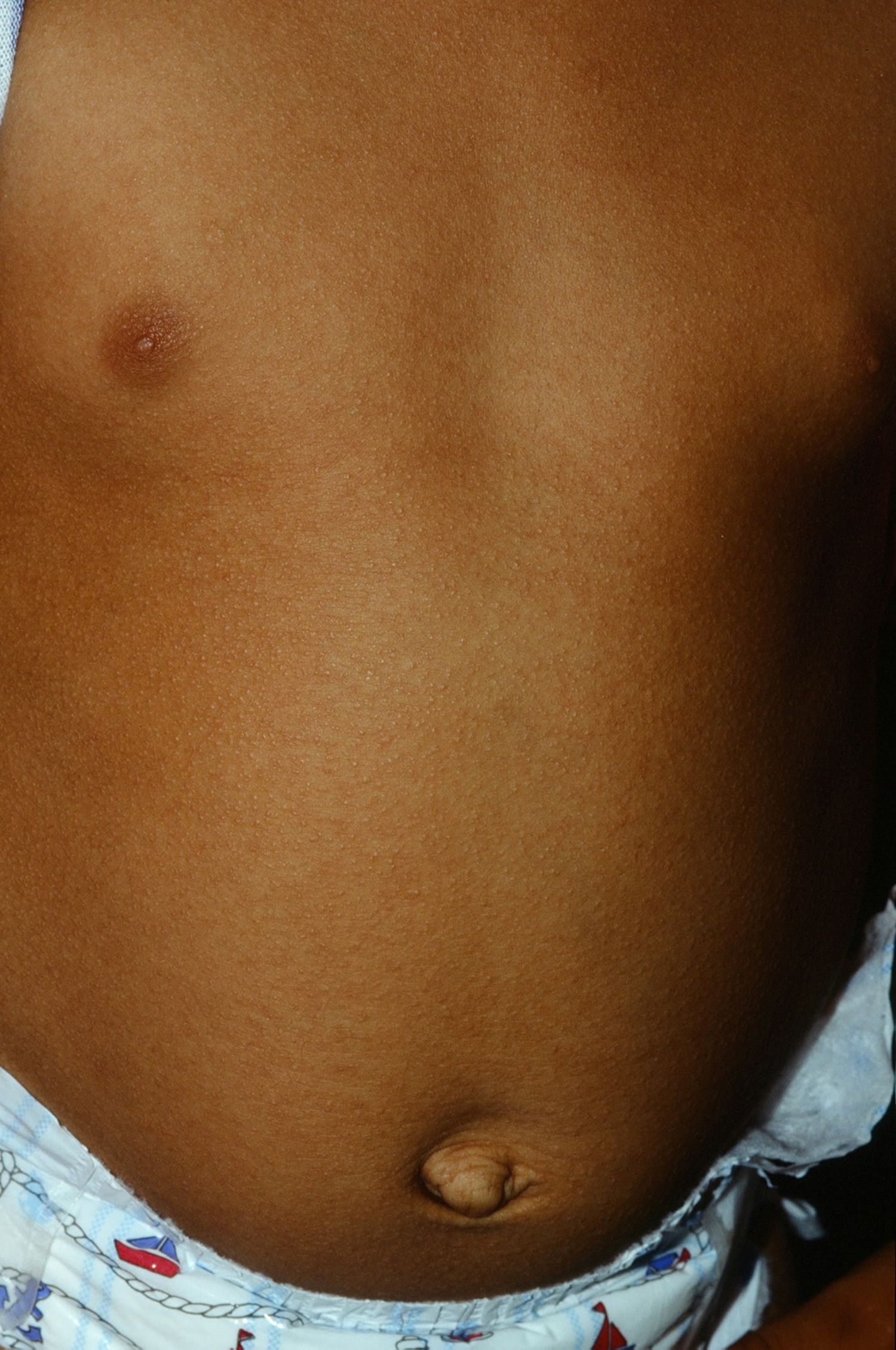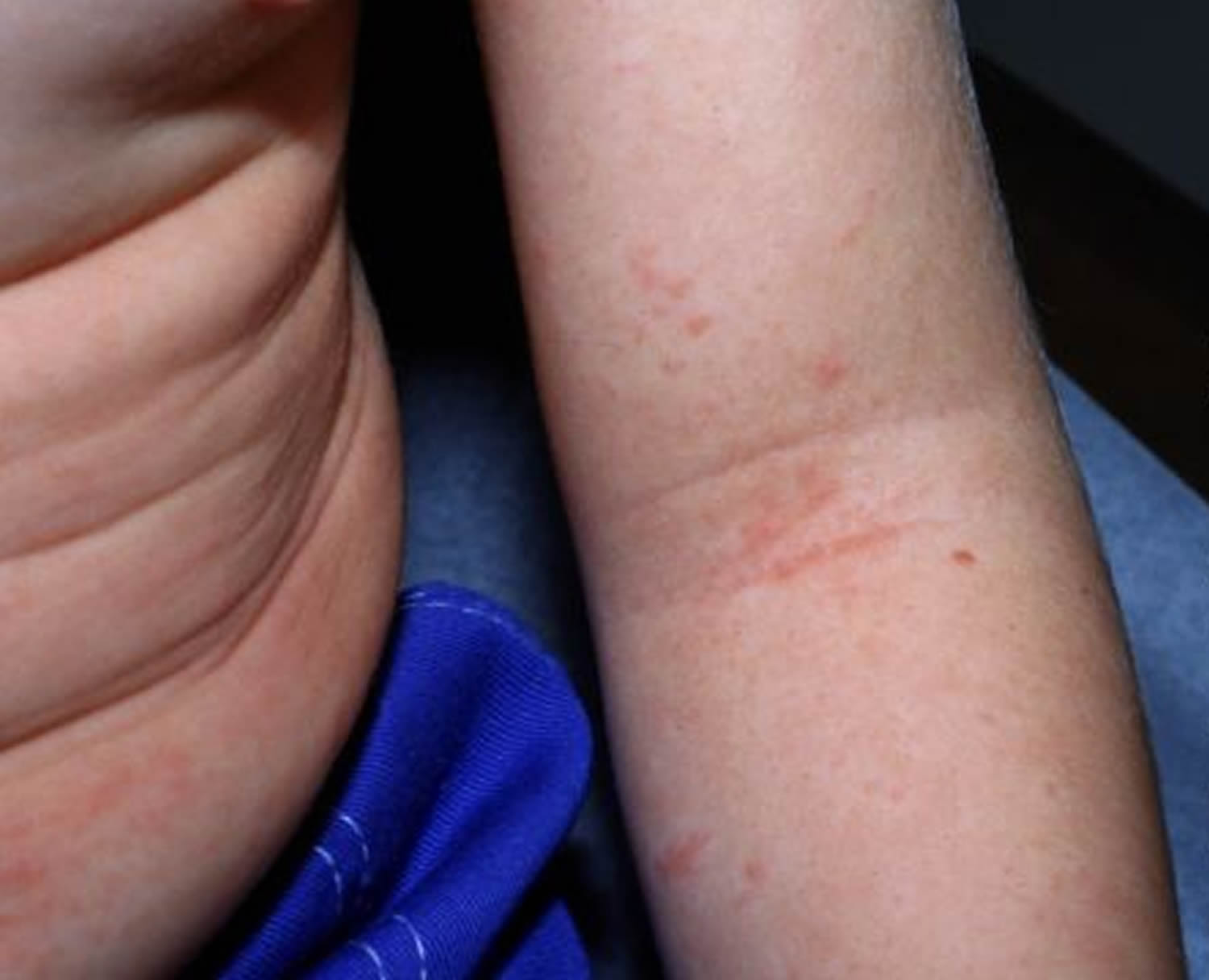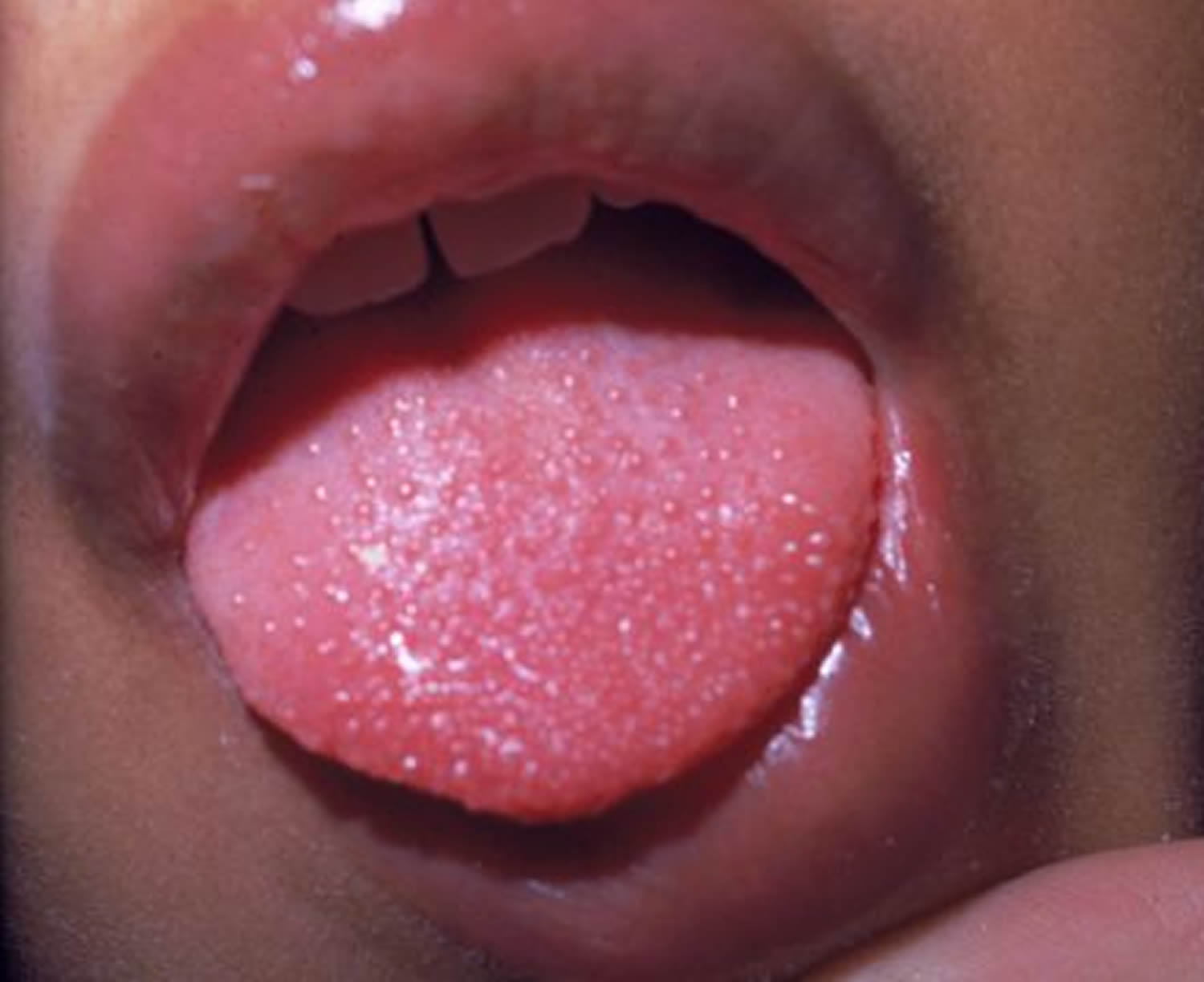Contents
What is scarlet fever
Scarlet fever is a contagious infection of the upper respiratory tract (mostly the throat) with a type of bacteria called Streptococcus that characteristically produces red, sandpaper-like rash (see Figure 1 below). Scarlet fever is also known as ‘scarlatina’. The infection is caused by a poison (toxin) produced by a bacterium called group A beta hemolytic Streptococcus. Some people are more sensitive to the toxin than others, so not everyone in a family who is infected will have the scarlet fever rash, even if they have the Strep throat infection. The tonsil or pharynx is the usual site of infection (“strep throat”), but surgical wounds or other foci are possible. Sometimes the area of infection is the skin rather than the throat, a condition called impetigo.
The scarlet fever rash appears 1–2 days after onset of symptoms (i.e, sore throat and fever) and starts on the neck and spreads downward on the body. The rash generally covers all of the skin on your body with the exception of the face. Applying pressure to the rash will cause the skin to turn white. After 3–4 days, the rash begins to fade, and sometimes the skin peels when the rash disappears, similar to sunburn.
Scarlet fever usually affects school-aged children aged 5 to 15, but can affect people of any age.
Scarlet fever is contagious to people who come into close contact with an infected child.
Scarlet fever isn’t usually serious and can be treated with antibiotics from your doctor. Once you’ve had it, you’re unlikely to get it again.
Treatment with antibiotics means most people recover in about a week, but left untreated it can spread to other parts of the body and cause serious health problems. Complications are rare but can include deeper tissue infections, rheumatic fever, and kidney disease.
Scarlet fever is encountered much less frequently today than it was in the past, and it is very rare in infants, as they are protected by their mother’s immune system components that prevent infection (antibodies) given to them at birth. Scarlet fever occurs in cycles in the population, depending on the strength of the bacterium. It is spread by fluids from the airways (i.e, cough, saliva, mucus).
Who’s at risk of scarlet fever infection?
- Scarlet fever is rare in children under the age of 2, because substances from the mother’s immune system (antibodies) protect the child up to that age.
- The peak ages for infection are 4–8 years. By age 10, most children have developed their own immunity to the toxin.
- Because infection is spread by fluids from the airways (respiratory secretions), infection rates are higher in crowded situations.
It is difficult to avoid infection of others who are not immune in the household. However, you might try to:
- Keep eating and clothing items used by an ill child away from other people, and wash them in hot soapy water.
- The child’s caregivers should wash their hands frequently.
- Keep the child comfortable with acetaminophen (Tylenol®) or ibuprofen for fever relief.
- Have your child eat soft foods, drink plenty of liquids, and apply lotions such as calamine for itching, if needed.
Pregnancy advice
There’s no evidence to suggest that getting scarlet fever during pregnancy will harm your baby. But it can make you feel unwell, so it’s best to avoid close contact with anyone who has it.
If you do get symptoms of scarlet fever, see your doctor for treatment.
The antibiotics used for scarlet fever are usually safe to take during pregnancy.
You should see a doctor if your child has a very sore throat and red rash.
If your child has scarlet fever, the doctor may prescribe antibiotics. If left untreated, the bacteria might spread to the tonsils, lungs, skin, kidneys, blood or middle ear. Antibiotics will prevent serious health problems including rheumatic fever, kidney disease, pneumonia and arthritis.
The doctor may also recommend rest, pain relief and that your child drinks a lot of water.
Your child will stop being infectious 24 hours after they start antibiotics. If they don’t have antibiotics, they can still be infectious for two to three weeks.
How do you get scarlet fever
Scarlet fever is caused by a group A streptococcal (bacterial) infection. The bacteria live in the nose and throat. When someone who is infected coughs or sneezes, the bacteria travel in small droplets of water called respiratory droplets. One of the ways you can get sick is if you breathe in those droplets or if you touch something that has the droplets on it and then touch your mouth, nose, or eyes.
Scarlet fever is spread by:
- coughing and sneezing
- contact with a contaminated surface, such as a plate or glass
- touching or kissing an infected person.
Children can also catch it by touching the sores of someone who has a scarlet fever skin infection.
Someone with scarlet fever is usually not able to spread the bacteria to others after they have taken the correct antibiotic for 24 hours or longer. If you are diagnosed with scarlet fever, you should stay home from work, school, or daycare until you no longer have a fever and have taken antibiotics for at least 24 hours so you don’t spread the infection to others.
Is scarlet fever contagious
Scarlet fever is very contagious. It’s spread in the tiny droplets found in an infected person’s breath, coughs and sneezes.
You can be infected if the droplets get into your mouth, nose or eyes – either by being in close contact with an infected person, or by touching something that has droplets on it.
To help stop the infection spreading:
- keep your child away from nursery or school for at least 24 hours after starting antibiotic treatment – adults should stay off work for at least 24 hours after starting treatment
- cover your mouth and nose with a tissue when you cough or sneeze – throw away used tissues immediately
- wash your hands with soap and water often, especially after using or disposing of tissues
- avoid sharing utensils, cups and glasses, clothes, baths, bed linen, towels or toys
How long is scarlet fever contagious
The infection is contagious from before the symptoms appear, until:
- 24 hours after starting antibiotic treatment
- up to two or three weeks later if you don’t take antibiotics
Scarlet fever usually clears up within a week, although the skin may peel for a few weeks after the other symptoms have passed.
Further problems due to scarlet fever are rare, but there’s a small risk of the infection spreading to other parts of the body and causing problems such as an ear infection or lung infection (pneumonia).
Contact your doctor if you or your child gets any new symptoms that you’re worried about in the weeks after a scarlet fever infection.
Scarlet fever rash
The scarlet fever rash:
- usually starts on the chest or tummy, before spreading to other areas
- is made up of pink-red blotches that may join up
- feels like sandpaper (this may be the most obvious sign in someone with dark skin)
- may be brightest red in body folds, such as the armpits or elbows
- turns white if you press a glass on it
Figure 1. Scarlet fever rash (note the faint pink “sandpaper-like” rash of scarlet fever on the chest and abdomen. Numerous tiny red bumps of scarlet fever are sometimes more easily felt than seen)
Figure 2. Scarlet fever rash (the red rash typical of scarlet fever)
Figure 3. Scarlet fever rash (note the body folds, such as the elbow creases, often have a rash that appears like red lines)
Figure 4. Scarlet fever tongue (“white strawberry tongue” of scarlet fever, with a white coating with red dots on the surface)
Figure 5. Red face
Figure 6. Scarlet fever rash – during the resolution phase of scarlet fever, the widespread rash begins to peel.
Scarlet fever long term effects
If scarlet fever goes untreated, the bacteria may spread to the:
- Tonsils
- Lungs
- Skin
- Kidneys
- Blood
- Middle ear
Post-streptococcal glomerulonephritis is an immunologically-mediated sequela of pharyngitis or skin infections caused by nephritogenic strains of group A Streptococcus or group A strep.
Rarely, scarlet fever can lead to rheumatic fever, a serious condition that can affect the:
- Heart
- Joints
- Nervous system
- Skin
Scarlet fever causes
What causes scarlet fever
Scarlet fever is caused by the same type of bacteria that cause strep throat. In scarlet fever, the bacteria release a toxin that produces the rash and red tongue.
The infection spreads from person to person via droplets expelled when an infected person coughs or sneezes. The incubation period — the time between exposure and illness — is usually two to four days.
Risk factors for getting scarlet fever
Anyone can get scarlet fever, but there are some factors that can increase your risk of getting this infection.
Scarlet fever, like strep throat, is more common in children than adults. It is most common in children 5 through 15 years old. It is rare in children younger than 3 years old. Parents of school-aged children and adults who are often in contact with children will have a higher risk for scarlet fever than adults who are not around children very often.
Close contact with another person with scarlet fever is the most common risk factor for illness. For example, if someone has scarlet fever, it often spreads to other people in their household.
Infectious illnesses tend to spread wherever large groups of people gather together. Crowded conditions — such as those in schools, daycare centers, or military training facilities — can increase the risk of getting a group A strep infection.
Scarlet fever prevention
The best way for your child to avoid scarlet fever is by washing their hands often, and to not share plates or utensils with other people.
To avoid giving it to other people, tell your child to cover his or her mouth and nose when coughing and sneezing to prevent the potential spread of germs.
Children with scarlet fever should stay home while they are unwell, and for at least 24 hours after starting antibiotics.
If your child has scarlet fever, wash his or her drinking glasses, utensils and, if possible, toys in hot soapy water or in a dishwasher.
Scarlet fever symptoms
Symptoms of scarlet fever usually appear between one and three days after infection and include a very red sore throat, fever and a red rash.
Red blotches are the first sign of the rash, which then changes to look like sunburn and feel like sandpaper. Scarlet fever sandpaper-like rash is characterized by 1–2 mm red bumps, which merge together, starting on the neck, then moving to the trunk, and finally to the arms and legs (extremities). It is sometimes a bit itchy. If scarlet fever develops on body creases (armpits, elbow folds), red streaks may appear.
The rash will probably appear about two days after the child starts feeling ill, but can appear before they feel sick or up to a week later. You may see it first on their neck, underarm or groin.
Fever, chills, body aches, nausea, vomiting, and loss of appetite may occur.
When the throat is the main area of infection, the tonsils may become enlarged, red, and tender. Other areas (lymph nodes) in the neck may become swollen. At first, the tongue has a white coating, giving a “white strawberry” tongue appearance, which then falls off (sheds) to reveal a bright red strawberry tongue. The rash does not affect the palms and soles at first, but later on, these areas may peel. The rash usually lasts for 4–5 days, and as it fades (subsides), skin on the neck and face start to peel, and eventually the hands and feet start to peel as well.
Scarlet fever signs and symptoms:
- A whitish coating on their tongue or throat
- Red bumps on their tongue – it looks like a strawberry
- Headaches
- Abdominal pain, nausea and vomiting
- Fever of 101 °F (38.3 °C) or higher
- Chills
- Very sore throat and tonsils sometimes with white or yellowish patches with difficulty in swallowing
- Enlarged glands in the neck (lymph nodes) that are tender to the touch
- Swollen glands
- Aches all over their body
- Red lines. The folds of skin around the groin, armpits, elbows, knees and neck usually become a deeper red than the surrounding rash.
- Flushed face. The face may appear flushed with a pale ring around the mouth.
Your child may also have flushed cheeks (Figure 5), a pale area around the mouth, or bright red skin creases under the arms, elbows and groin area.
The red face rash (Figure 5):
- The rash doesn’t usually spread to the face, but the cheeks may turn very red.
- This may look a bit like sunburn.
- The area around the mouth usually stays pale.
The rash and the redness in the face and tongue usually last about a week. Once the rash fades, you may notice peeling skin around the finger tips, toes and groin (see Figures 6).
Scarlet fever diagnosis
An illness that includes a red rash and sore throat can be caused by many viruses and bacteria. It is very important to determine if group A strep is the cause. A rapid strep test or a throat culture is needed.
During the physical exam, your doctor will:
- Look at the condition of your child’s throat, tonsils and tongue
- Feel your child’s neck to determine if lymph nodes are enlarged
- Assess the appearance and texture of the rash
Throat swab
If your doctor suspects strep is the cause of your child’s illness, he or she will also swab the tonsils and back of your child’s throat to collect material that may harbor the strep bacteria.
A rapid strep test involves swabbing the throat and testing the swab to quickly see if group A strep is causing the illness. Tests for the strep bacteria are important because a number of conditions can cause the signs and symptoms of scarlet fever, and these illnesses may require different treatments. If the test is positive, doctors can prescribe antibiotics.
If the rapid strep test is negative, but a doctor still strongly suspects scarlet fever, then they can take a throat culture swab to see if bacteria grow from the sample. This culture test requires more time to get the results, but can be important to use in children and teens because they are at risk of getting rheumatic fever if their scarlet fever infection is not treated. For adults, it is usually not necessary to do a throat culture following a negative rapid strep test since there is little risk of adults getting rheumatic fever following scarlet fever.
If there are no strep bacteria, then some other factor is causing the illness.
Scarlet fever treatment
If Streptococcus infection is confirmed, prescription antibiotics are will be prescribed, to be taken for about 10 days.
You or your child should start feeling better after a day or two, but make sure you finish the whole course of treatment. Failure to follow the treatment guidelines may not completely eliminate the infection and will increase your child’s risk of developing complications.
While taking antibiotics:
- rest and drink plenty of fluids
- take acetaminophen (paracetamol) or ibuprofen if you’re uncomfortable or have high temperature (don’t give aspirin to children under 16)
- try to avoid spreading the infection
Your child can return to school when he or she has taken antibiotics for at least 24 hours and no longer has a fever.
Scarlet fever home remedies
You can take a number of steps to reduce your child’s discomfort and pain.
- Treat fever and pain. Use ibuprofen (Advil, Children’s Motrin, others) or acetaminophen (Tylenol, others) to control the fever and minimize throat pain.
- Provide adequate fluids. Give your child plenty of water to keep the throat moist and prevent dehydration.
- Prepare a saltwater gargle. If your child is able to gargle water, give him or her salty water to gargle and then spit out. This may ease the throat pain.
- Humidify the air. Use a cool mist humidifier to eliminate dry air that may further irritate a sore throat.
- Offer lozenges. Children older than age 4 can suck on lozenges to relieve a sore throat.
- Provide comforting foods. Warm liquids such as soup and cold treats like ice pops can soothe a sore throat.
- Avoid irritants. Keep your home free from cigarette smoke and cleaning products that can irritate the throat.












